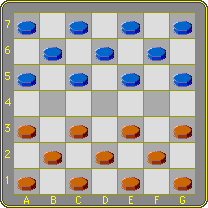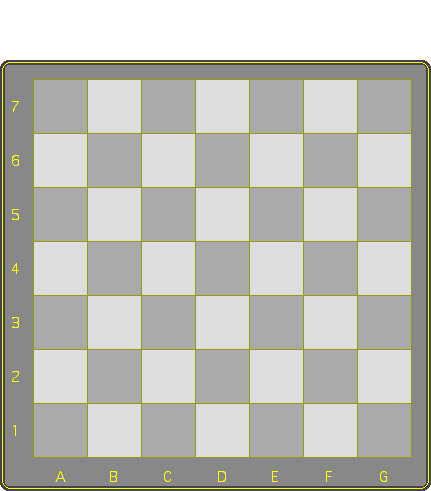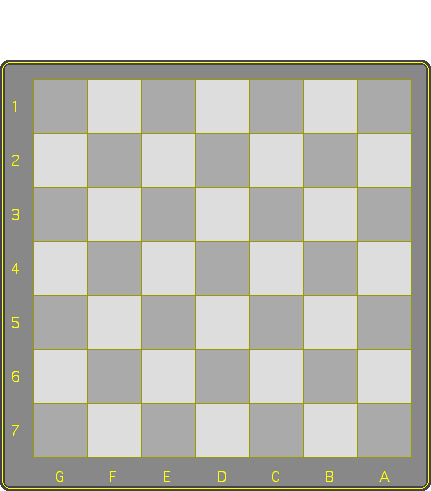Lasker reduced the size of the board to 7x7, effectively leaving 25 squares to play on. With 2x11 men in the initial position, the board not just looks crammed, it is crammed.
 | Here are some of the ways a white piece may look in Lasca. By the nature of the capturing mechanism, prisoners will always be under a cap of the opponent's men (or kings), never in between them. In the above example, the four pieces on the left move and capture as a man, because there's a man on top. The three pieces on the right have a king on top and thus may move and capture as kings. Left to right we see a single man, a single man with three prisoners, three men with one prisoner, two men and a king with four prisoners, a king, a king with two prisoners and a king with five prisoners, one of them a king. |
Rules
Barring the boardsize, the only difference between Checkers and Lasca is that in Lasca a jumped man or king, either as a single piece or as the topman or -king of a column, is not removed from play, but taken along as a prisoner under the capturing piece.
The above diagram shows the board and the pieces in initial position. There are two players, black and white. White begins. Players move, and must move, in turn.
The rules mention men and kings. A king is a promoted man. Columns with a man on top will also be called 'a man' and columns with a king on top will also be called 'a king'.
Moving
- Capture precedes over a non-capturing move. If the player to move has no capture available, he has two options:
- Moving a man
- Moving a king
- A man or a column with a man on top moves diagonally forwards to an adjacent vacant square. If it thus reaches the back rank the top-man is crowned to king and this marks the end of the move.
- A king or a column with a king on top moves diagonally forwards or backwards to an adjacent vacant square.
All pieces thus remain on the dark colored squares. From here on 'forwards' or 'backwards' will be understood as 'diagonally'.
Capture
Capture precedes over a non-capturing move. If the player to move can make a capture, he must do so.
- A man captures an opponent's piece, man or king, by jumping over it, in a forwards direction, to the square immediately beyond, which must be vacant for the capture to take place.
If from this square it can proceed in a similar manner, a jump in the same- or a perpendicular direction, it must do so, and proceed thus till the capture has been fully completed. If the column it controls thus lands on the back rank, the topman is crowned to king and the move ends. - A king captures an opponent's piece, man or king, by jumping over it, in a forwards or backwards direction, to the square immediately beyond, which must be vacant for the capture to take place. If it can proceed in a similar manner, a jump in the same- or a perpendicular direction, it must do so and proceed thus till the capture has been fully completed.
- In the course of a capture, a king may visit a square more than once, but there are different opinions on whether it may jump a piece more than once (going roundabout). The mindsports applet doesn't mind, so players have to agree on that point before starting a game.
- A player may choose freely between different captures that may be available, regardless of the number or value of the piece(s) taken.
Object
If a player cannot legally move he loses the game. This may come about by losing all pieces or by having all pieces blocked. Draws may occur by 3-fold or mutual agreement. There are some special tournament rules to cover draws.
| An example game More or less to show what's wrong with Lasca. External links Lasca © Emanuel Lasker | |||||||






